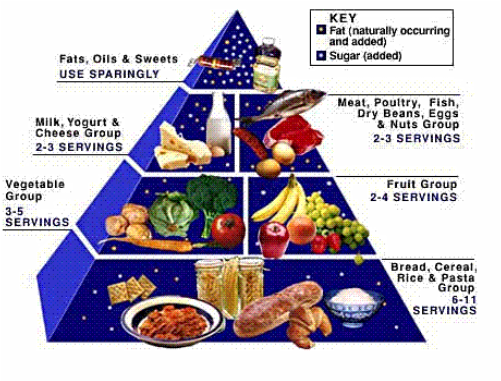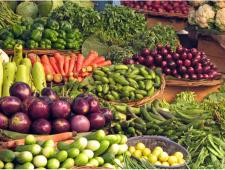Four Food Groups inside the Food Pyramid
There are four of the basic food groups that have now been placed into the Food Pyramid for a guide on eating healthy nutrition. This guide will show you just how many servings of each group you should eat each day. You’ll notice that the foods at the wider base offer you more servings a day while the top portion of the guide includes those foods that you should be eating more sparingly.
The concept behind the Food Pyramid is to eat servings from each of the different levels every day. This gives you with balance and variety that you need in your diet on a daily basis. By following these suggestions you can be certain that you are getting the right amount of nutrients in your body.
This is the type of healthy nutrition plan that you want to adapt to.
When you eat in this manner you can quickly begin improving your eating habits and in short order, you’ll feel the health of your body improve.

Separating the Four Groups inside the Food Pyramid
As you will notice in the diagram above the grain group is at the base of the pyramid. The foods you’ll find in this section are primarily cereals, pasta, breads and rice. You should normally be eating between 6-11 servings from this group each day unless you are attempting to do a no or low carbohydrate diet.
This particular food group consists mostly of carbohydrates and can provide your body with energy and fuel. Depending on your level of physical activity you may need to adjust this a bit because excess carbs can pack on the weight if your body is idle and you’re not burning the fuel from all those calories fast enough.
This is why professional athletes will often load up on carbs before a big race or sporting event. People who participate in marathons, triathlons, iron man competitions and long distance cycling events will do a “carb load” prior to the big event.
Next we have the fruit and vegetable group and you should be eating larger amounts of these foods as well. Fruits and vegetables are rich in vitamins, minerals, phyto-nutrients, fiber and more. Fiber is extremely important to your digestive system and you should eat at 6-9 servings of fruits and vegetables a day and if not, it’s a good idea to supplement in the areas that you are lacking.
Moving on to the next level of the Food Pyramid we have the meat and dairy products. This group is rich in protein which is essential for everyone and health and fitness nuts may want to increase their protein intake based on the intensity of their workouts. Protein and dairy originate from animal and plant sources. These include food items such as milk, fish, poultry, eggs, nuts, cheese and beans.
All of the foods in this group contain important nutrients and protein that can’t be found as abundantly in other food groups. Calcium, iron, phosphorus, zinc and B vitamins are essential for bone and muscle development.
The foods in this group are necessary for your body and are extremely important for children as they require more of these in their diet as they develop and grow.
Last but not least the top of our Food Pyramid contains sugars, oils and fats. You’ll find these in a variety of foods, they are very important but should be used sparingly especially in the case of sugar which offers your body mostly empty calories that provide you with little to no worthy nutritional value. Some fats and oils however are a must have for a healthy nutrition plan.
Here are a few food sources to spark ideas when planning meals:
Some of the best sources of carbohydrates include: Wheat of all varieties, corn, rice, barley, rye and oats. Varieties of potatoes like white, golden, red and sweet potatoes. The Legumes like pinto beans, peas, limas, navy beans, black beans, lentils and peanuts. Nuts of all kinds including coconuts.
Some of the best sources of fruits and vegetables include: All fruits fall into this category but some are very high in natural sugar such as grapes so be mindful of this when choosing your food.
Apples, lemons, oranges, apricots, peaches, grapes, pears, strawberries, avocadoes, tomatoes, watermelon, muskmelon, cantaloupe, casaba, honey dew, bananas, prunes, grapes, raisins, dried currants, figs, dates, persimmons, blackberries, blueberries, cherries, cranberries, currants, mulberries, gooseberries, huckleberries, olives, nectarines, pineapples, plums and raspberries.
With vegetables you also have lots of choices: Asparagus, beets, cabbage, carrots, turnips, parsnips, cauliflower, cucumber, egg plant, lettuce, celery, endive, romaine, chicory, cucumbers, cabbage, celery cabbage, parsley, field lettuce, okra, onions, radish, summer squash, spinach, kohlrabi, kale, Brussels sprouts, cone artichoke, chard, string beans, celery, turnip tops, lotus, endive, dandelion, oyster plant, rutabaga and garlic.
Some of the best sources of proteins include: Animal meat of most any kind like chicken, turkey, beef, lamb, veal, pork, geese and ducks. Legumes provide protein and are important to vegetarians. Fish is known to be beneficial for its “good oils” but is also high in protein. There are many choices when it comes to fish like shrimp, shell fish, herring, pickerel, salmon, trout, bass, pike, red snapper, tuna and a whole host of fresh and saltwater varieties not listed here.
Deep cold-water fish are prized for their valuable oils as opposed to freshwater fish so this is good to keep in mind when preparing your menu.
Nuts like almonds, Brazil nuts, walnuts, pecans, macadamia nuts, filberts and hazel nuts are all good protein sources and some of the best sources of dairy include: cheese, milk, yogurt, Greek yogurt, sour cream, and cottage cheese.
At the top of the Food Pyramid we have the fats and oils.
Some of the best sources of fats and oils include: Dairy products such as cream, butter and some of the richer cheeses. Fatty fish like herring, shad, salmon and trout being high up on the list. Legumes, nuts, coconuts, cotton seed oil, flax seed oil, sesame seed oil, olive oil and more.
Understanding the Food Pyramid helps you fit together a more balanced and healthy nutrition plan and is the basics of most preplanned packaged diets. Next, we’ll briefly touch on malnutrition with “Ending the Confusion about Malnutrition” and why it’s not just a third world problem…
And why it could be your problem too.
 The combining of foods is generally pretty easy to understand and this is the basis for this healthy nutrition guide. It all started from the studying of the effects of gastric physiology. It evolved from the understanding of how digestive juices and enzymes truly function and how certain combinations of foods are digested more easily and efficiently than other foods.
The combining of foods is generally pretty easy to understand and this is the basis for this healthy nutrition guide. It all started from the studying of the effects of gastric physiology. It evolved from the understanding of how digestive juices and enzymes truly function and how certain combinations of foods are digested more easily and efficiently than other foods.





